New generation reefs
Six artificial reefs made with a 3D printer were submerged in 2017 in the Larvotto Marine Protected Area at a depth of 30 meters. This was a first in the Mediterranean and a first globally in terms of the size of the printed reefs.
These “new generation” reefs have made it possible to develop research programs bringing together a large scientific community.
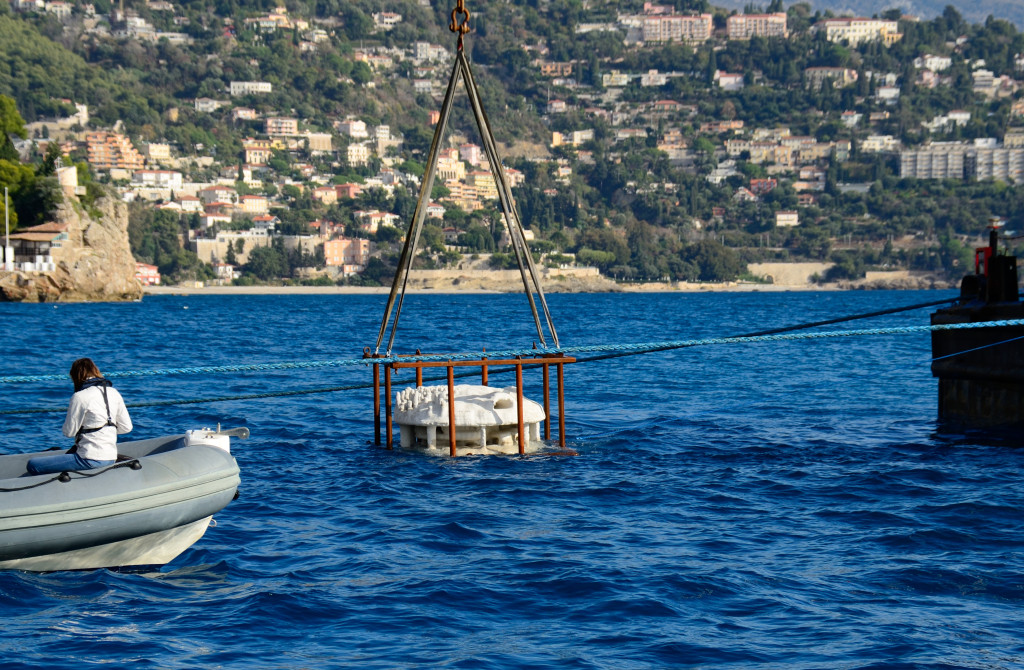
Immersion in 2017 of one of the 3D printed reefs in the Larvotto Marine Protected Area.
The birth of the project
In 2010, the Boskalis Company, a Dutch maritime assistance company for offshore works specializing in dredging, worked on a project to establish coral reefs in Jamaica. Astrid KRAMER, environmental engineer, launched a study on artificial reefs and discovered an article presenting an Italian inventor, Enrico DINI, who uses 3D printing to create artificial reefs with sand. He came up with the idea of creating reefs with dredged sand, a natural product more suitable than the concrete usually used. In 2014, his project won the “Innovation Challenge” which allows Boskalis Company employees to present innovative ideas.
Shortly after, His Serene Highness Prince Albert II of Monaco on an official visit to the Netherlands, accompanied by H.E.Mr. Bernard FAUTRIER, then Vice-President of the Prince Albert II of Monaco Foundation, met several industrialists including representatives of the company Boskalis who presented the concept of artificial reefs made with a 3D printer. The innovative nature of these reefs allowed Boskalis to set up a pilot project in Monaco in 2015, coordinated by Jamie LESCINSKI, oceanography engineer, in partnership with the Prince Albert II of Monaco Foundation and the AMPN, which is responsible for implementing this project in the Larvotto Marine Protected Area.
One project, multiple actors
This multi-stakeholder but also multidisciplinary project brought together managers, experts in marine ecology, research institutes, experts in reef design and 3D printing. The initiative was strongly supported by the Prince Albert II of Monaco Foundation, which promotes innovative programs and is involved in the development of Marine Protected Areas around the world.
Among the different actors:
The Boskalis Company, project leader; the D-Shape Company, designer of the 3D printer; the AMPN; Professor Patrice FRANCOUR of the ECOSEAS mixed research unit, formerly ECOMERS (Université Côte d’Azur; CNRS); the BOREA mixed research unit (National Museum of Natural History Paris; Pierre and Marie Curie University; Institute of Research for Development; CNRS; University of Caen Normandy; University of the Antilles); PlanBlue, a start-up from the Max-Planck Institute (Bremen, Germany)
- 2019 : Boskalis, Immersion of 3D reefs -
The different phases of the project: from design to development of research programs
Phase 1: Choice of design
Thanks to the help of Professor Patrice FRANCOUR, specialist in fish populations and artificial reefs, the design of the reefs was imagined in consultation with the AMPN and other partners. The reefs have been designed to recreate the specific habitats of heritage species such as groupers, octopuses and lobsters. The use of 3D printing made it possible to envisage a complex design, close to that of natural habitats, favoring their colonization by different species.
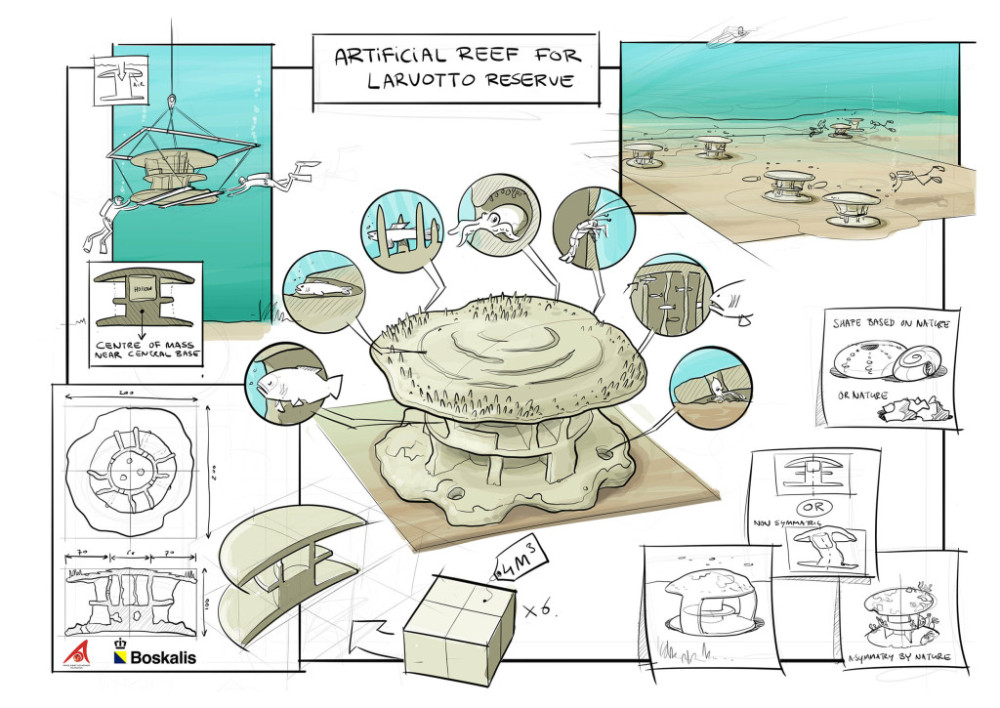
The result of the various consultation meetings between specialists to define the choice of design.
Phase 2: Material research program
The Boskalis Company launched a research program with the Universities of Eindhoven and Delft in the Netherlands as well as with the Austrian industrial group RHI in order to optimize the material used for printing reefs. This material, based on Dolomite sand with the addition of volcanic ash, had to meet several requirements: be water resistant, sufficiently strong and compatible with 3D printing technology, have no impact on the marine environment, be able to "dry" within a few weeks after printing. Numerous tests of resistance to pressure and bending were also carried out to guarantee the future resistance of the reefs in a marine environment.
Phase 3: Biofilm research program
This program was launched by Professor Patrice FRANCOUR (ECOSEAS Mixed Research Unit) in collaboration with two researchers, Cédric HUBAS and Dominique LAMY (BOREA Mixed Research Unit), through the Master's and Doctorate work of Elisabeth RIERA.
The objective of this program was to determine the link between the quality of the biofilm and the substrate by comparing colonization on different types of substrates (Dolomite sand, natural rock and especially concrete, the product commonly used to make artificial reefs).
No study had previously focused on comparing the biofilm on the different materials used for reef construction, whether from a biochemical or biological point of view. However, this knowledge is essential in the choice of the material.
Biofilm is important to study. Indeed, microorganisms such as bacteria or unicellular eukaryotes are the first to colonize a new submerged substrate. They secrete extracellular substances which form a thin layer on the surface of the substrate; all together, micro-organisms and secreted substances, constitute the biofilm. This biofilm is necessary for subsequent colonization by algal spores and macroinvertebrate larvae (macrofouling). Furthermore, depending on the secretions of the biofilm to adapt to its substrate, the biofilm can also trap polluting elements present in the water column, such as heavy metals or hydrocarbons, which can have consequences for the future macrofouling communities. The quality and richness of the biofilm therefore constitute determining elements for the subsequent colonization of an artificial reef.
Experiments took place in 2016 and 2017, on 2 sites (Larvotto and Roquebrune-Cap-Martin MPAs), in order to compare the colonization of biofilm and macrofouling on samples of the 3 substrates (Dolomite sand, natural rock and concrete). ).

Doctors Elisabeth RIERA and Emna BEN LAMINE conditioning the plates of the different materials on which the biofilm developed.
Phase 4: Research program on the analysis of the complexity of artificial reefs
This program was also launched by Professor Patrice FRANCOUR, in collaboration with Cédric HUBAS, Johanna BARTHELEMY (Master student) and Elisabeth RIERA (doctoral student).
Its goal was to develop a method to precisely measure the structural complexity of artificial reefs.
Indeed, artificial reefs must present great complexity to imitate the characteristics of natural habitats. In order to improve the integration of artificial structures into ecosystems, a new quantitative method has been developed to assess their complexity, using 3D models of artificial reefs.
The method uses six parameters to link the geometric and informational complexity of the structures evaluated. These parameters meet the ecological needs of communities, in terms of surface area and space available at different scales, and in terms of diversity and distribution of available micro-habitats.
This classifies artificial reefs based on their complexity and can help design more efficient artificial reefs in the future, while providing a quantitative way to analyze the correlation between complexity and diversity at the scale of artificial reefs. In addition, the method can help identify specific complexity thresholds to attract certain species or achieve particular ecological objectives.
This approach filled a gap regarding the lack of quantitative methods for assessing the complexity of artificial reefs. In addition to methods for evaluating the quality of materials, it makes it possible to produce more efficient and ecologically integrated artificial reefs.
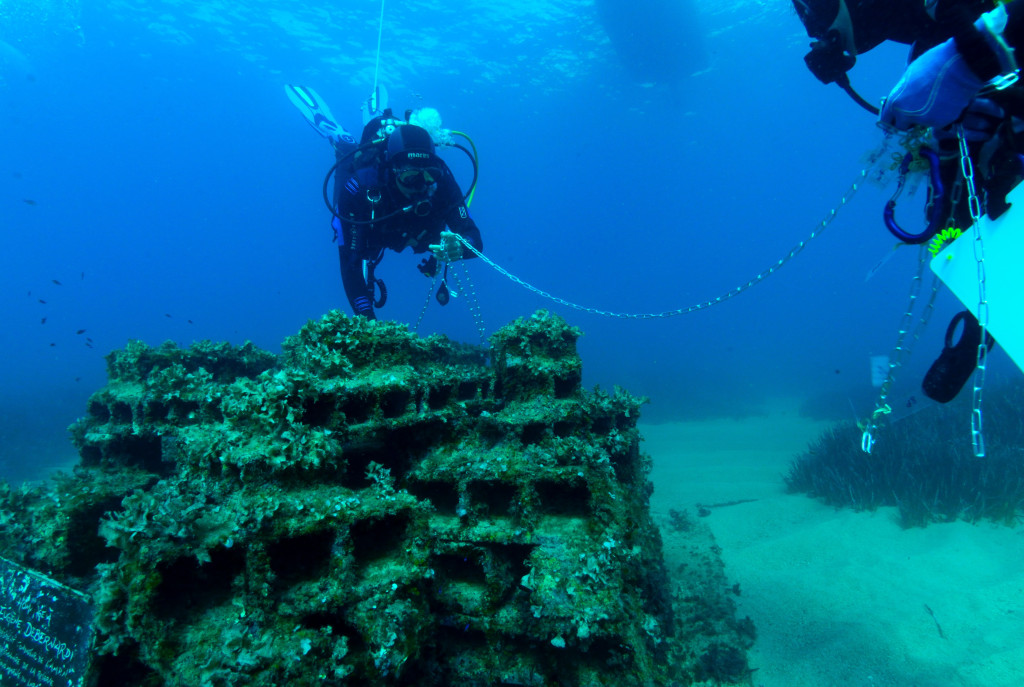
Doctors Alexis PEY and Elisabeth RIERA measuring the complexity of one of the artificial reefs of the Larvotto MPA.
Monitoring 3D reef colonization
Monitoring of fish populations:
In order to characterize the evolution of fish assemblages installed in and around 3D reefs, two complementary methods are used.
The first is a conventional method of visual census by underwater diving (UVC) which allows to carry out an exhaustive and quantitative inventory of all the fish present in and around the reefs. Monitoring is carried out twice a year, during June and September, by THALASSA Marine research.
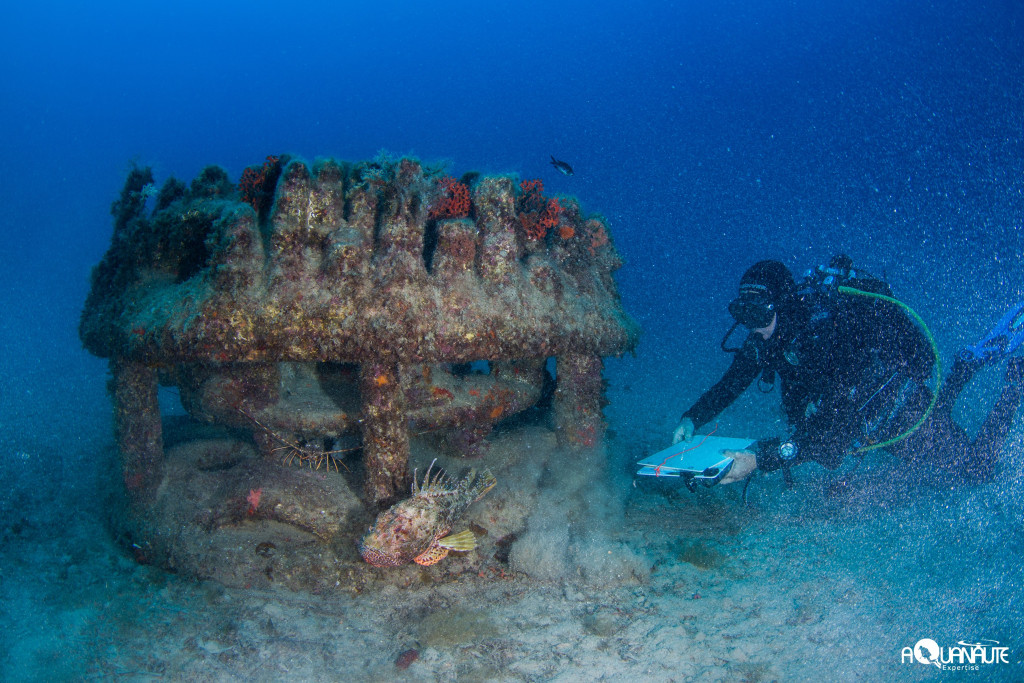
Dr. Alexis PEY from THALASSA Marine Research monitoring fish populations on 3D reefs.
The second method, complementary to the first, is based on automated photographic monitoring. Three GoPro cameras with a wide angle and associated with additional batteries are placed 1 m from a reef on tripods and left at the seabottom for several hours, programmed to take a photo every 30 seconds. This makes it possible to monitor fish populations in a manner that complements underwater visual censuses. The fish that are most fearful of scuba divers are better taken into account than by traditional methods. From each recorded image, the fish species present throughout the recording are counted and identified in order to evaluate two main ecological indicators, density and species diversity. The technical constraints inherent in this protocol do not allow exhaustive observation of the species located inside or behind the reef. These data, although partial, are compiled in a database in order to i) identify families and species, ii) note particular behaviors (feeding, passage, shelter, etc.), iii) define density and frequency of reef colonization by species. Individuals whose species could not be defined are counted and identified as “indeterminate”. This monitoring is carried out twice a year, during June and September, by THALASSA Marine research.

Experimental diagram of the positioning of GoPro cameras around the 3D reefs of Larvotto.
In 2023, the data collected made it possible to identify 35 different species of fish since the reefs were submerged.
Monitoring benthic colonization
The 3D reef material was developed to approximate the chemical properties of the marine environment. It therefore has the advantage of limiting the presence of heavy metals, chemical adjuvants and has a neutral pH, thus allowing healthier colonization of benthic communities.
The colonization of artificial reefs by benthic organisms actively participates in the process of structural complexity of the new habitats offered by the reefs. Colonization by macrofouling is generally determined by the local biological environment. The algae are the first recruited, followed after several weeks by a more diverse association composed of hydroids, serpulid polychaetes, barnacles and molluscs. The diversity of benthic communities on reefs favors the reproduction, recruitment and feeding of mobile species (fish and large vagile invertebrates), thus contributing to the proper functioning of their population. Community balance follows an interactive and dynamic process governed by environmental conditions and interspecific competition of the assemblage. Benthic communities can present different assemblages depending on the material used for the construction of artificial reefs. It is therefore fundamental to know the role of this type of material in natural colonization processes. The study of this ecological compartment is therefore very important in order to have an overall image of the state of the food web at the level of the 3D reefs, considering that they were constructed with a material whose chemical properties are close to those of the marine environment.
Two methods were used to monitor benthic colonization:
a) The use of a hyperspectral camera:
This technique was tested for the first time in the Mediterranean in July 2018 as part of the 3D reef research program and renewed in 2020. The program, initiated by Professor Patrice FRANCOUR, was led following his death by Francesca ROSSI (CNRS Researcher, UMR ECOSEAS) and Elisabeth RIERA (Post-Doctoral Student).
This camera, developed by PlanBlue, a start-up from the Max Planck Institute in Bremen, Germany, scans the seabed using hyperspectral imaging. Hyperspectral imaging is a technique combining imaging and spectroscopy where each image is taken for one band of the electromagnetic spectrum ranging from visible to near infrared, whereas the human eye sees light in only three bands (red, green and blue). Each species or community of species presents a particular spectral signature which can therefore be used to identify it or to measure parameters linked to its physiology. The development of a submersible camera makes it possible to acquire images of the different colonized substrates during underwater diving and to quickly obtain a quantity of data that goes beyond the simple identification of the species present. This speed and ease of characterization are the main advantages of this camera. Once validation has been carried out (association between the characteristics of the light spectrum and a species or group of species), it is then easy to determine the composition and certain physiological activities (such as photosynthesis) of the macrofouling species.
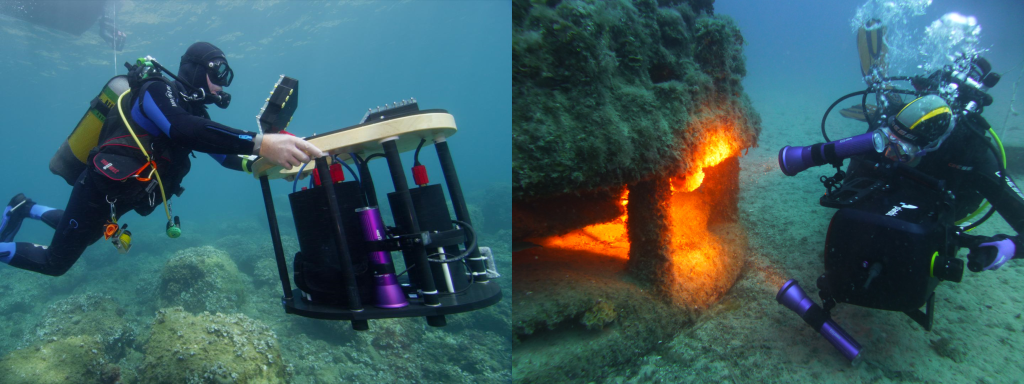
Use of the hyperspectral camera while diving.
On the left, Pr. Patrice FRANCOUR with the prototype and on the right, Dr. Elisabeth RIERA with the final model.
In the case of 3D reefs, the use of the hyperspectral camera, as part of the research work of Doctor Elisabeth RIERA, made it possible in particular to determine that these “new generation” reefs are favorable to the establishment of more complex communities, more healthy than the “old generation” reefs made of concrete and submerged nearby more than 45 years ago.
- 2018 : Monaco Info Report, Evénement : une caméra hyperspectrale immergeable -
b) Data collection by scuba diving:
Doctor Alexis PEY from the THALASSA Marine research and Mr. Stéphane JAMME (Aquanaute Expertise), carried out photographic campaigns on the 6 3D reefs between June 2021 and September 2022, i.e. between 44 and 59 months after their immersion. Macrobenthic species were visually identified from the 491 photographs. The identification of organisms was carried out as far as possible down to species and their classification.
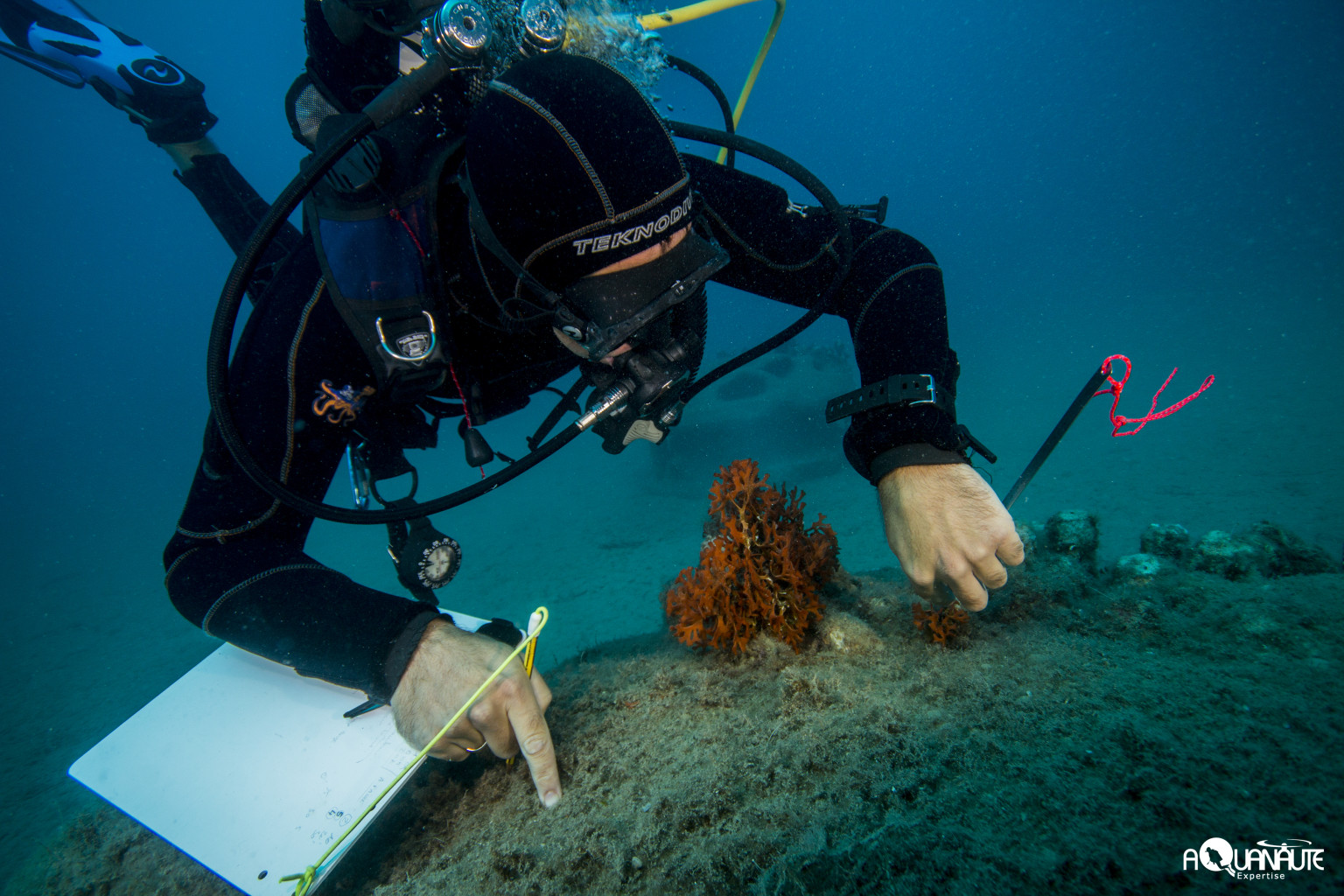
Dr. Alexis PEY from THALASSA Marine Research carrying out benthic colonization measurements on 3D reefs.
The analyzes reveal that the intrinsic complexity of the 3D reefs of Larvotto has allowed the development of a rich and diverse benthic population (up to 82 species identified) characterized by the encounter of various biocenoses present on the 3D reefs (coralligenic biocenosis, semi-obscure caves and caves and tunnels in total darkness). Observations made during the various dives reveal a strong colonization of artificial reefs which should improve over time with the installation of new species already present on natural or artificial rocks of Larvotto. This study will be subject to long-term monitoring in order to evaluate the dynamics of colonization of 3D reefs over time.
Technical sheet of 3D reefs
- Number of reefs: 6
Also smaller experimental reefs were added (a quarter of the size of the 6 reefs) which can be used for various experiments in a natural environment by the UMR ECOSEAS.
- Unit weight: 2,500 kilos
- Size: 1.95 meters in diameter / 1.25 meters in height
- Volume: 1 m3 of material per reef / 4 m3 of overall volume of the reef (its shape)
- Material: Dolomite sand + volcanic ash
Related scientific publications
Doctoral thesis:
“Towards a purposeful construction of a new generation of artificial reefs : Comparative analyses of the intrinsic factors favouring their colonization from micro to macro-scale” by Dr. Riera, Elisabeth, 2020
Doctoral thesis supervised by P. Francour and C. Hubas
Environmental sciences, University of Côte d'Azur
Riera E, Lamy D, Goulard C, Francour P, Hubas C (2018) Biofilm monitoring as
a tool to assess the efficiency of artificial reefs as substrates: toward 3D
printed reefs. Ecological Engineering 120:230–237. https://doi.org/10.1016/j.ecoleng.2018.06.005
Riera E, Mauroy M, Francour P, Hubas C (2023) Unleashing The Potential Of Artificial Reefs Design: A Purpose-Driven Evaluation Of Structural Complexity. Methods in Ecology and Evolution (Manuscript ID MEE-23-11-676)
Riera E, Hubas C, Ungermann M, Rigot G, Pey A, Francour P, Rossi F (2023) Artificial reef effectiveness changes among types as revealed by underwater hyperspectral imagery. Restoration Ecology 31:8. https://doi.org/10.1111/rec.139
